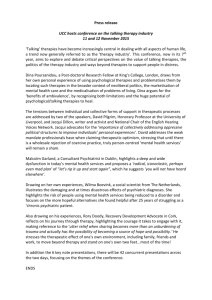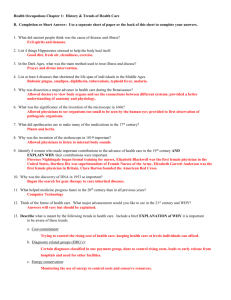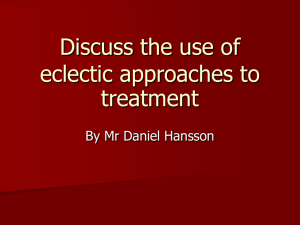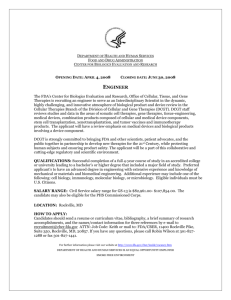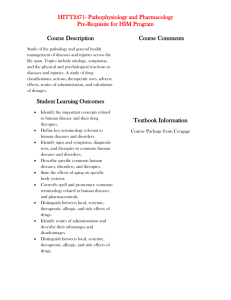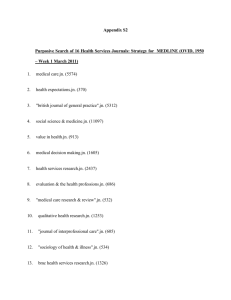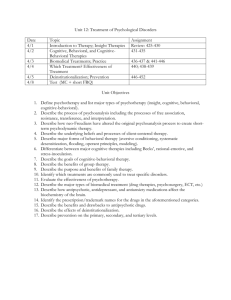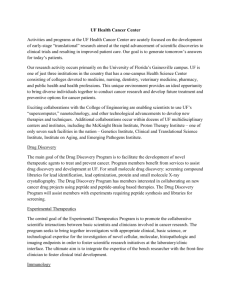Microsoft Word - The AIDS InfoNet
advertisement
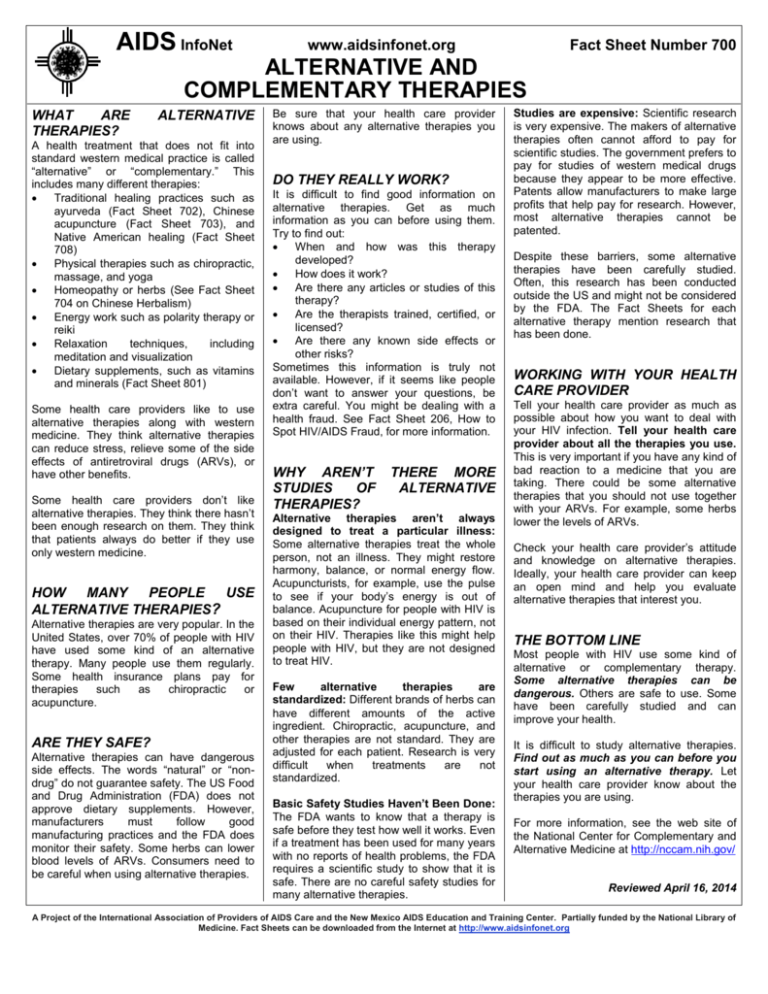
AIDS InfoNet www.aidsinfonet.org Fact Sheet Number 700 ALTERNATIVE AND COMPLEMENTARY THERAPIES WHAT ARE THERAPIES? ALTERNATIVE A health treatment that does not fit into standard western medical practice is called “alternative” or “complementary.” This includes many different therapies: Traditional healing practices such as ayurveda (Fact Sheet 702), Chinese acupuncture (Fact Sheet 703), and Native American healing (Fact Sheet 708) Physical therapies such as chiropractic, massage, and yoga Homeopathy or herbs (See Fact Sheet 704 on Chinese Herbalism) Energy work such as polarity therapy or reiki Relaxation techniques, including meditation and visualization Dietary supplements, such as vitamins and minerals (Fact Sheet 801) Some health care providers like to use alternative therapies along with western medicine. They think alternative therapies can reduce stress, relieve some of the side effects of antiretroviral drugs (ARVs), or have other benefits. Some health care providers don’t like alternative therapies. They think there hasn’t been enough research on them. They think that patients always do better if they use only western medicine. HOW MANY PEOPLE USE ALTERNATIVE THERAPIES? Alternative therapies are very popular. In the United States, over 70% of people with HIV have used some kind of an alternative therapy. Many people use them regularly. Some health insurance plans pay for therapies such as chiropractic or acupuncture. ARE THEY SAFE? Alternative therapies can have dangerous side effects. The words “natural” or “nondrug” do not guarantee safety. The US Food and Drug Administration (FDA) does not approve dietary supplements. However, manufacturers must follow good manufacturing practices and the FDA does monitor their safety. Some herbs can lower blood levels of ARVs. Consumers need to be careful when using alternative therapies. Be sure that your health care provider knows about any alternative therapies you are using. DO THEY REALLY WORK? It is difficult to find good information on alternative therapies. Get as much information as you can before using them. Try to find out: When and how was this therapy developed? How does it work? Are there any articles or studies of this therapy? Are the therapists trained, certified, or licensed? Are there any known side effects or other risks? Sometimes this information is truly not available. However, if it seems like people don’t want to answer your questions, be extra careful. You might be dealing with a health fraud. See Fact Sheet 206, How to Spot HIV/AIDS Fraud, for more information. WHY AREN’T STUDIES OF THERAPIES? THERE MORE ALTERNATIVE Alternative therapies aren’t always designed to treat a particular illness: Some alternative therapies treat the whole person, not an illness. They might restore harmony, balance, or normal energy flow. Acupuncturists, for example, use the pulse to see if your body’s energy is out of balance. Acupuncture for people with HIV is based on their individual energy pattern, not on their HIV. Therapies like this might help people with HIV, but they are not designed to treat HIV. Few alternative therapies are standardized: Different brands of herbs can have different amounts of the active ingredient. Chiropractic, acupuncture, and other therapies are not standard. They are adjusted for each patient. Research is very difficult when treatments are not standardized. Basic Safety Studies Haven’t Been Done: The FDA wants to know that a therapy is safe before they test how well it works. Even if a treatment has been used for many years with no reports of health problems, the FDA requires a scientific study to show that it is safe. There are no careful safety studies for many alternative therapies. Studies are expensive: Scientific research is very expensive. The makers of alternative therapies often cannot afford to pay for scientific studies. The government prefers to pay for studies of western medical drugs because they appear to be more effective. Patents allow manufacturers to make large profits that help pay for research. However, most alternative therapies cannot be patented. Despite these barriers, some alternative therapies have been carefully studied. Often, this research has been conducted outside the US and might not be considered by the FDA. The Fact Sheets for each alternative therapy mention research that has been done. WORKING WITH YOUR HEALTH CARE PROVIDER Tell your health care provider as much as possible about how you want to deal with your HIV infection. Tell your health care provider about all the therapies you use. This is very important if you have any kind of bad reaction to a medicine that you are taking. There could be some alternative therapies that you should not use together with your ARVs. For example, some herbs lower the levels of ARVs. Check your health care provider’s attitude and knowledge on alternative therapies. Ideally, your health care provider can keep an open mind and help you evaluate alternative therapies that interest you. THE BOTTOM LINE Most people with HIV use some kind of alternative or complementary therapy. Some alternative therapies can be dangerous. Others are safe to use. Some have been carefully studied and can improve your health. It is difficult to study alternative therapies. Find out as much as you can before you start using an alternative therapy. Let your health care provider know about the therapies you are using. For more information, see the web site of the National Center for Complementary and Alternative Medicine at http://nccam.nih.gov/ Reviewed April 16, 2014 A Project of the International Association of Providers of AIDS Care and the New Mexico AIDS Education and Training Center. Partially funded by the National Library of Medicine. Fact Sheets can be downloaded from the Internet at http://www.aidsinfonet.org

